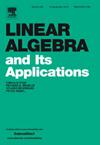欧氏距离矩阵问题中光滑应力函数的局部和全局最小值
IF 1.1
3区 数学
Q1 MATHEMATICS
引用次数: 0
摘要
我们考虑当给定嵌入维数为d的欧氏距离矩阵EDM时,在n个点的位形矩阵P∈Rn×d的精确恢复中出现的具有四次目标函数的非凸最小化问题。是否存在允许局部非全局最小化lngm的条件,这是文献中一个未解决的问题。证明了当n≤d+1时,所有二阶平稳点都是全局极小点。并且,对于d=1和n≥7>;d+1,我们给出了一个可以解析地展示局部非全局最小值的例子。对于更一般的情况,我们用数值方法找到了二阶平稳点,并证明了四次非凸极小化问题的二阶平稳点确实存在。因此,我们肯定地回答了先前关于它们存在的悬而未决的问题。我们找到lngm的方法是新颖的,因为我们首先利用平移和旋转不变性来去除Hessian的奇异性,并将问题的大小从P中的nd个变量减少到(n−1)d - d(d−1)/2个变量。这允许稳定牛顿方法,并找到满足严格二阶充分最优性条件的例子。能够找到全局最小值的动机是获得配置矩阵的精确恢复,即使在数据有噪声和/或不完整的情况下,也不需要借助于凸(半定规划)松弛的近似解。在我们的工作过程中,我们提出了新的见解,当长平滑应力函数存在和不存在。本文章由计算机程序翻译,如有差异,请以英文原文为准。
On the local and global minimizers of the smooth stress function in Euclidean distance matrix problems
We consider the nonconvex minimization problem, with quartic objective function, that arises in the exact recovery of a configuration matrix of n points when a Euclidean distance matrix, EDM, is given with embedding dimension d. It is an open question in the literature whether there are conditions such that the minimization problem admits a local nonglobal minimizer, lngm. We prove that all second-order stationary points are global minimizers whenever . And, for and , we present an example where we can analytically exhibit a local nonglobal minimizer. For more general cases, we numerically find a second-order stationary point and then prove that there indeed exists a nearby lngm for the quartic nonconvex minimization problem. Thus, we answer the previously open question about their existence in the affirmative. Our approach to finding the lngm is novel in that we first exploit the translation and rotation invariance to remove the singularities of the Hessian, and reduce the size of the problem from nd variables in P to variables. This allows for stabilizing Newton's method, and for finding examples that satisfy the strict second order sufficient optimality conditions.
The motivation for being able to find global minima is to obtain exact recovery of the configuration matrix, even in the cases where the data is noisy and/or incomplete, without resorting to approximating solutions from convex (semidefinite programming) relaxations. In the process of our work we present new insights into when lngms of the smooth stress function do and do not exist.
求助全文
通过发布文献求助,成功后即可免费获取论文全文。
去求助
来源期刊
CiteScore
2.20
自引率
9.10%
发文量
333
审稿时长
13.8 months
期刊介绍:
Linear Algebra and its Applications publishes articles that contribute new information or new insights to matrix theory and finite dimensional linear algebra in their algebraic, arithmetic, combinatorial, geometric, or numerical aspects. It also publishes articles that give significant applications of matrix theory or linear algebra to other branches of mathematics and to other sciences. Articles that provide new information or perspectives on the historical development of matrix theory and linear algebra are also welcome. Expository articles which can serve as an introduction to a subject for workers in related areas and which bring one to the frontiers of research are encouraged. Reviews of books are published occasionally as are conference reports that provide an historical record of major meetings on matrix theory and linear algebra.

 求助内容:
求助内容: 应助结果提醒方式:
应助结果提醒方式:


